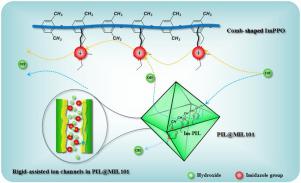当前位置:
X-MOL 学术
›
J. Ind. Eng. Chem.
›
论文详情
Our official English website, www.x-mol.net, welcomes your
feedback! (Note: you will need to create a separate account there.)
Highly hydroxide-conductive anion exchange membrane with PIL@MOF-assisted ion nanochannels
Journal of Industrial and Engineering Chemistry ( IF 5.9 ) Pub Date : 2021-02-01 , DOI: 10.1016/j.jiec.2020.11.020 Jia Chen , Mingming Guan , Kai Li , Shaokun Tang
Journal of Industrial and Engineering Chemistry ( IF 5.9 ) Pub Date : 2021-02-01 , DOI: 10.1016/j.jiec.2020.11.020 Jia Chen , Mingming Guan , Kai Li , Shaokun Tang

|
Abstract A highly hydroxide-conducting anion exchange membrane with well-organized multi ion channels were fabricated via incorporating poly ionic liquids modified MIL101 (PIL@MIL101) into imidazolated poly (2,6-dimethyl-1,4-phenylene oxide) (ImPPO). 1-Vinyl-3-ethylimidzolium bromine was first immobilized in MIL101 cages via supercritical fluid impregnation method. Afterwards, the rigid-assisted ion nanochannels were constructed by in-situ polymerization of ionic liquids within the long-range ordered pores of MIL101. Meanwhile, PPO was functionalized by 1-ethyl-2-methyimidzolium to prepare comb-shaped ImPPO with enhanced microphase separation structure. Then the PIL@MIL101 was combined with ImPPO to fabricate hybrid anion exchange membrane with well-organized multiple ion channels. The OH− conductivity of the hybrid membrane significantly reached 138 mS/cm at 80 °C (176% higher than that of pristine membrane). Furthermore, the stability and mechanical properties of the hybrid membranes were remarkably enhanced. The excellent performances render the hybrid membrane a good candidate for the application in anion exchange membrane fuel cells.
中文翻译:

具有 PIL@MOF 辅助离子纳米通道的高氢氧化物导电阴离子交换膜
摘要 通过将聚离子液体改性的 MIL101 (PIL@MIL101) 掺入咪唑化聚 (2,6-二甲基-1,4-苯醚) (ImPPO) 中,制备了一种具有良好组织的多离子通道的高氢氧化物传导性阴离子交换膜。 . 1-Vinyl-3-ethylimidzolium 溴首先通过超临界流体浸渍法固定在 MIL101 笼中。然后,通过离子液体在 MIL101 的长程有序孔内的原位聚合构建刚性辅助离子纳米通道。同时,通过1-乙基-2-甲基咪唑对PPO进行功能化,制备出具有增强微相分离结构的梳状ImPPO。然后将 PIL@MIL101 与 ImPPO 结合以制造具有组织良好的多离子通道的混合阴离子交换膜。混合膜的 OH− 电导率在 80 °C 下显着达到 138 mS/cm(比原始膜高 176%)。此外,混合膜的稳定性和机械性能显着提高。优异的性能使混合膜成为阴离子交换膜燃料电池应用的良好候选者。
更新日期:2021-02-01
中文翻译:

具有 PIL@MOF 辅助离子纳米通道的高氢氧化物导电阴离子交换膜
摘要 通过将聚离子液体改性的 MIL101 (PIL@MIL101) 掺入咪唑化聚 (2,6-二甲基-1,4-苯醚) (ImPPO) 中,制备了一种具有良好组织的多离子通道的高氢氧化物传导性阴离子交换膜。 . 1-Vinyl-3-ethylimidzolium 溴首先通过超临界流体浸渍法固定在 MIL101 笼中。然后,通过离子液体在 MIL101 的长程有序孔内的原位聚合构建刚性辅助离子纳米通道。同时,通过1-乙基-2-甲基咪唑对PPO进行功能化,制备出具有增强微相分离结构的梳状ImPPO。然后将 PIL@MIL101 与 ImPPO 结合以制造具有组织良好的多离子通道的混合阴离子交换膜。混合膜的 OH− 电导率在 80 °C 下显着达到 138 mS/cm(比原始膜高 176%)。此外,混合膜的稳定性和机械性能显着提高。优异的性能使混合膜成为阴离子交换膜燃料电池应用的良好候选者。











































 京公网安备 11010802027423号
京公网安备 11010802027423号